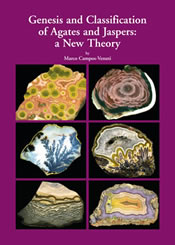
Genesis and Classification of Agates and Jaspers:
a New Theory
by Marco Campos-Venuti
A person must understand something exceptionally well to develop a successful method of classification. In this book, Dr. Marco Campos-Venuti explains jaspers and agates like no one has before. He presents a genetic classification scheme for jaspers and considers the internal events of agates in a facies model. Jaspers are gem materials formed from altered sediments and modified igneous materials. Agates are deposited, often in a sequence, by chemically active fluids in the fractures and cavities of the shallow subsurface.
After reading this book, you will look at jaspers and agates with an educated eye and see evidence of how they formed in their colors and patterns. I have been an enthusiastic reader of geology for over 50 years, and this is one of the most original, educational, and thought-provoking books that I have had the pleasure of reading. If you enjoy jaspers and agates, you must read this book.
An 8" x 11.25" paperback with 160 pages and tons of informative color photos.
Genesis and Classification of Agates and Jaspers:
| |
| Introduction | 7 |
JASPERS | |
Chapter 1 - Classification of Jaspers | 11 |
| Oceanic Jaspers | 12 |
| Flints | 13 |
| Abyssal jaspers | 15 |
| The Banded Iron Formation (BIF) | 17 |
| Volcanic Jaspers | 20 |
| Stratiform jaspers | 20 |
| Massive blocky jaspers | 24 |
| Rhyolitic jaspers | 28 |
| Jaspers pseudomorphic on fossil | 33 |
| Chemical Jaspers | 36 |
| Orbed jaspers | 36 |
| Brecciated jaspers | 39 |
| Jasp-agates | 41 |
Chapter 2 - Genesis of Jaspers | 45 |
| Silica in Solution | 45 |
| Abyssal jaspers | 47 |
| Volcanic jaspers | 48 |
| Thunder egg formation | 51 |
| Fumarole activity | 55 |
| Jaspers pseudomorphic on fossils | 56 |
| Chemical jaspers | 56 |
| Brecciated jaspers | 62 |
| Fracturing of chemical jaspers | 64 |
| Volumetric problems of chemical jaspers | 66 |
| Jasp-agates | 73 |
| Source of silica and geologic setting | 74 |
| Conclusions | 75 |
AGATES | |
Chapter 3 - Facies in Agates | 79 |
| Facies of an agate nodule | 81 |
| Facies 1 - First chalcedony layer | 82 |
| Facies 2a - Banded agate: hemiagate | 85 |
| Facies 2b - Banded agate: horizontal banding | 86 |
| Facies 2c - Banded agate: concentric banding | 86 |
| Facies 3 - Horizontal white bands | 88 |
| Facies 4 - Macrocrystalline quartz | 89 |
| Non-crystalline inclusions: mosses and plumes | 90 |
Chapter 4 - Genesis of First Chalcedony Layer | 97 |
| Structures and behavior of mosses | 97 |
| Influence of gravity in plumes | 104 |
| Color of mosses and plumes | 108 |
| Magic Gardens | 109 |
| Genesis of the first chalcedony layer (facies 1) | 111 |
Chapter 5 - Genesis of Banded Agate | 115 |
| Structures of bands | 115 |
| Fortified agates | 121 |
| Primary colors | 122 |
| Secondary colors | 124 |
| Connective channels and interruptions of the bands | 130 |
| Horizontal banding | 133 |
| Quantitative analysis | 137 |
| Morphology of the bands and migration of the centroid | 137 |
| Stratigraphy of a banded agate | 139 |
| Influence of climatic conditions | 140 |
| Types of agate depending on host rock | 142 |
| Conclusions | 144 |
Chapter 6 - Other Kinds of Agates and Chalcedonies | 147 |
| Chalcedony without bands | 147 |
| Banded agates without the first chalcedony layer | 151 |
| Lace agates | 151 |
| Beacon agates | 154 |
| Conclusions and classification of non-crystalline silica | 155 |
| Bibliography | 159 |
ADVERTISEMENT
